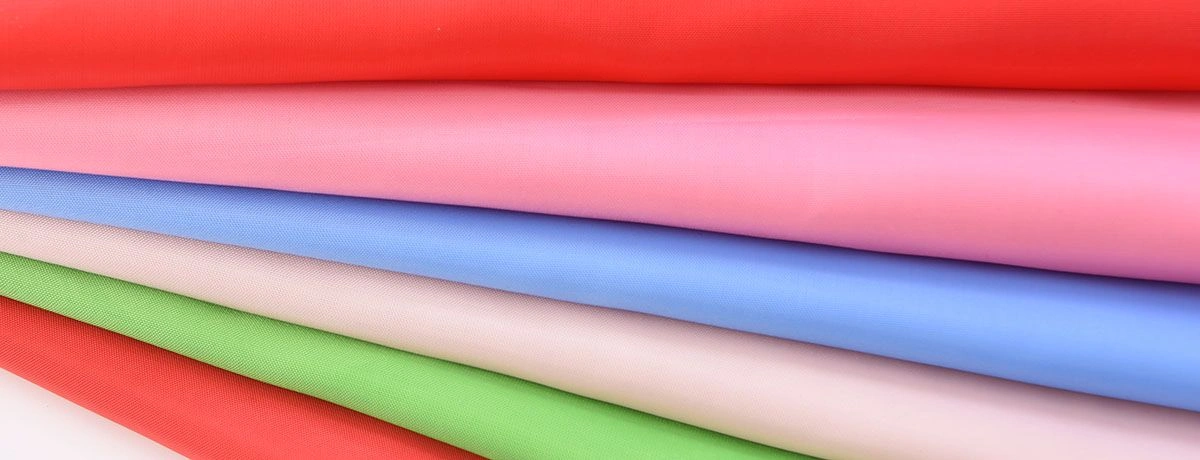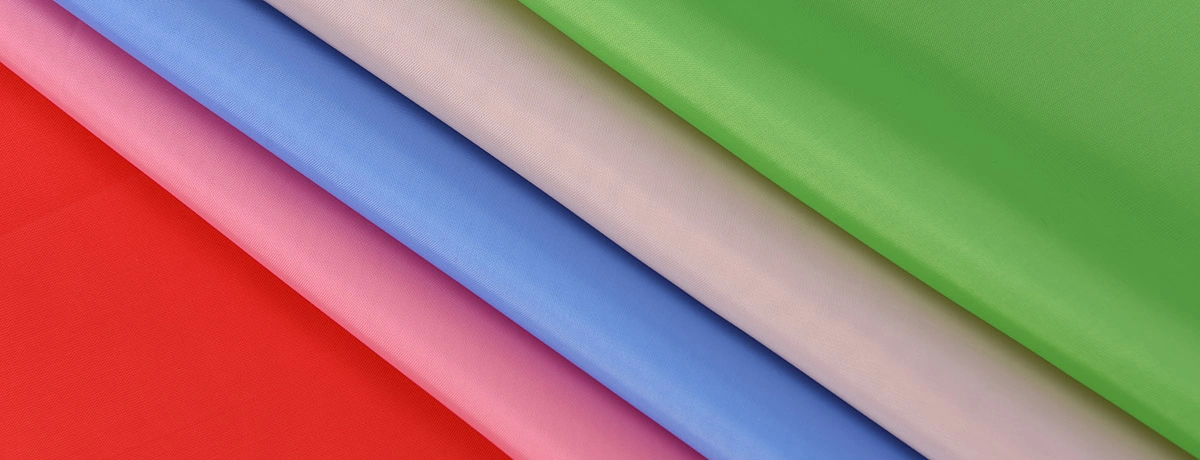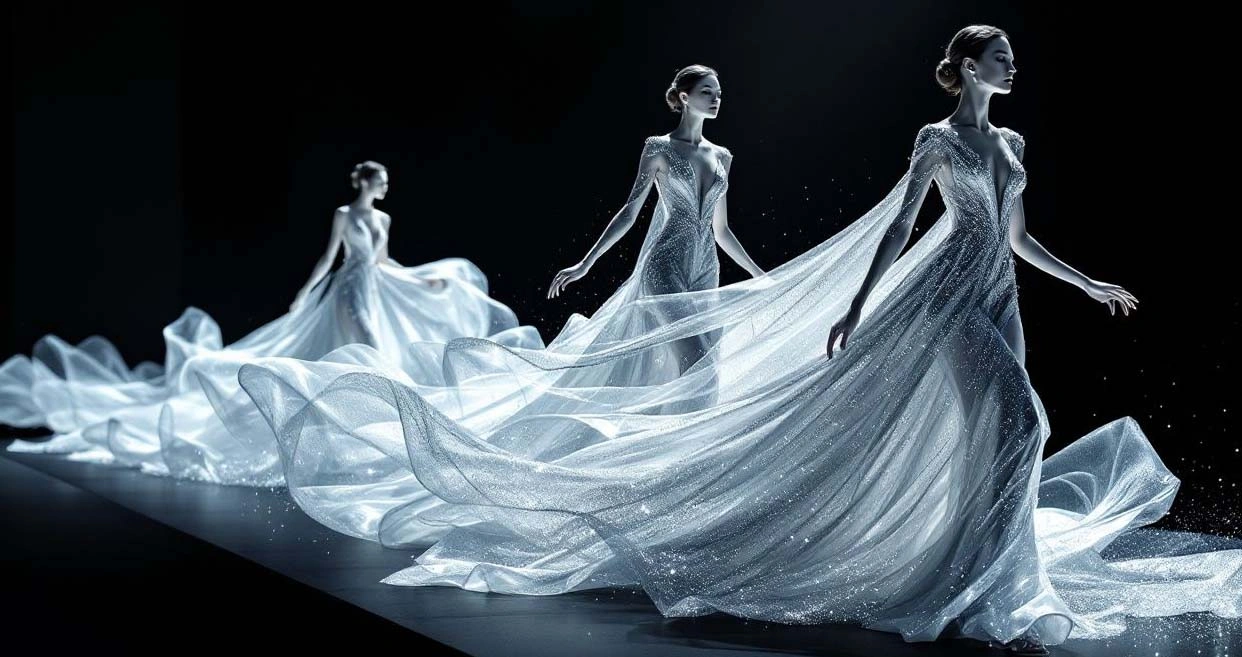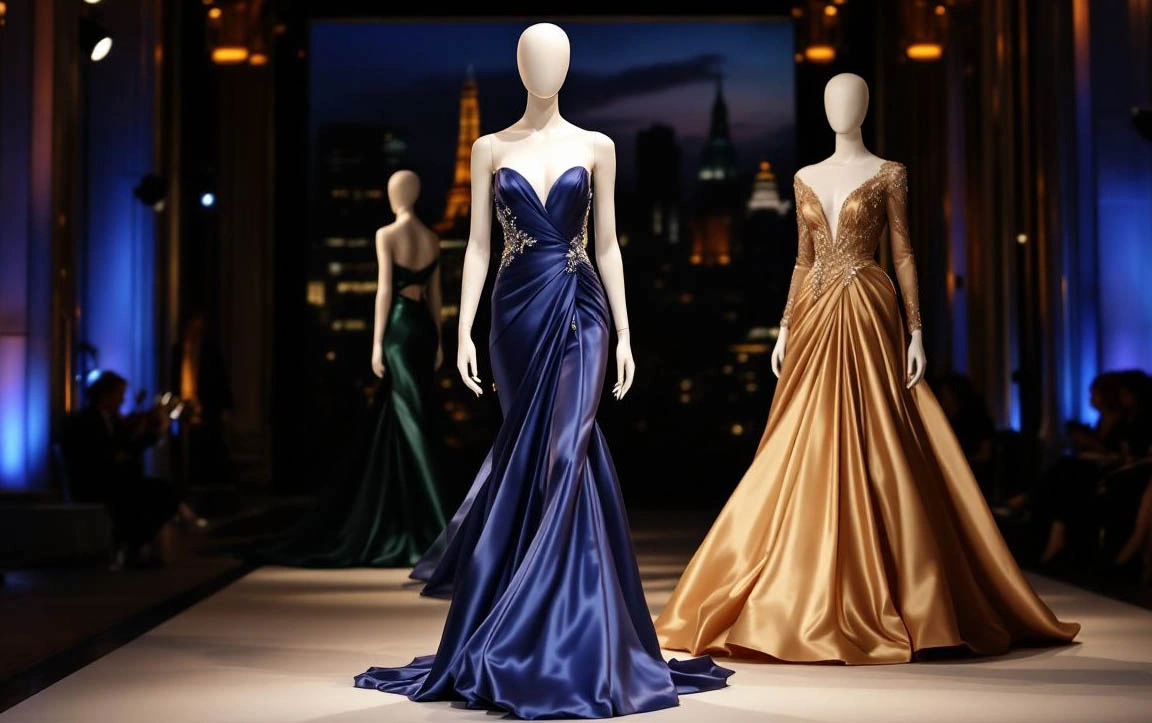Taffeta Fabric: Properties, Uses, and Care Guide

Taffeta is a fabric celebrated for its crisp texture and elegant sheen. Made from silk or synthetic materials, it maintains its shape and makes a unique rustling sound, known as ‘scroop.’ This article will explain what taffeta is, its key characteristics, different types, and how to care for it.
Key Takeaways
-
Taffeta fabric is a luxurious material known for its crisp texture, excellent shape retention, and distinct rustling sound, making it ideal for formal wear and high-end applications.
-
The production of taffeta involves a plain-weave technique and twisting of threads, resulting in various types such as silk, polyester, yarn dyed, and shot silk taffeta, each with unique qualities and uses.
-
Taffeta’s advantages include its durability and elegant appearance, while disadvantages comprise lack of breathability and specific care requirements, necessitating careful handling and maintenance.
What is Taffeta Fabric?

Taffeta is a soft and luxurious fabric known for its unique look and feel. The name ‘taffeta’ originates from the Persian word ‘tafta,’ meaning ‘twisted woven’. This fabric is traditionally made from silk thread, which gives it a distinct elegance and sheen. However, modern taffeta fabrics can also be produced from synthetic materials like polyester and nylon, making them more accessible and versatile.
One of the most striking characteristics of taffeta fabric is its excellent shape retention. This means that garments made from taffeta can maintain their form without distortion, contributing to their elegant and polished look. Additionally, taffeta is known for its crisp, lightweight texture and lustrous sheen, which adds to its luxurious appeal. When moved, taffeta produces a distinctive rustling sound, often referred to as ‘scroop,’ which further enhances its unique charm.
Taffeta’s lightweight and smooth texture make it an ideal choice for a variety of high-end applications. Whether used in evening gowns, wedding dresses, or sophisticated home décor, taffeta brings a touch of elegance and refinement to any project. Its versatility and timeless beauty ensure that taffeta remains a staple in the world of luxury fabrics.
How is Taffeta Fabric Made?
The creation of taffeta fabric involves a meticulous weaving process that contributes to its distinctive characteristics. Taffeta is produced using a plain-weave technique, where a single weft thread alternates over and under a warp thread, resulting in a checkerboard-like pattern. This method of weaving not only gives taffeta its smooth and glossy surface but also ensures its durability and strength.
A key aspect of taffeta’s production is the twisting of threads during the weaving process. This twisting is essential for giving taffeta its characteristic stiffness and structured feel. The combination of the plain weave technique and the twisting of the threads results in a fabric that is both crisp and stable, making it ideal for creating garments and items that require a defined shape and form.
Types of Taffeta Fabrics

Taffeta fabrics come in a variety of types, each with its own unique qualities and applications. These include silk taffeta, polyester taffeta, yarn dyed taffeta, piece dyed taffeta, shot silk taffeta, and paper taffeta. Each type of taffeta offers different textures, colors, and finishes, allowing designers and consumers to choose the perfect taffeta for their specific needs.
Here’s an in-depth look at the characteristics and uses of different types of taffeta fabrics.
Silk Taffeta
Silk taffeta is considered the crème de la crème of taffeta fabrics. Made from raw silk taffeta yarns, this type of taffeta is known for its luxurious quality and is often used in high-end fashion. Its smooth texture and lustrous sheen make silk taffeta ideal for gowns, formalwear, and eveningwear, adding sophistication and elegance.
Silk taffeta primarily comes in two types: yarn-dyed and piece-dyed. Yarn-dyed taffeta involves dyeing the yarns before weaving, resulting in vibrant and consistent colors. Piece-dyed taffeta, dyed after weaving, features a softer texture and a more subtle color palette.
Both types are prized for their quality and are commonly used in haute couture and luxury fashion.
Polyester Taffeta
Polyester taffeta offers a cost-effective alternative to its silk counterpart, without compromising on quality and appearance. This type of taffeta is known for its crisp, smooth texture and a lustrous sheen that closely mimics the look of silk. One of the primary advantages of polyester taffeta is its durability, making it suitable for a wide range of applications, from fashion to home décor.
Polyester taffeta also maintains its shape well, making it practical for everyday use and easier to care for than silk taffeta. Properly cared for, polyester taffeta resists fading and damage, enhancing its longevity and making it a popular choice for budget-conscious consumers. Moreover, it is available in a wide array of colors, offering versatility for various projects.
Yarn Dyed Taffeta
Yarn dyed taffeta is renowned for its vibrant and rich colors, achieved by dyeing the yarns before they are woven into fabric. This dyeing process allows for deeper color saturation and a variety of shades, making yarn dyed taffeta an attractive option for high-end fashion and elegant designs. This results in distinctive color patterns and textures, adding unique visual appeal to garments and accessories.
The luxurious appearance of yarn dyed taffeta makes it a favorite among designers for creating striking and sophisticated pieces. Yarn dyed taffeta stands out for its exceptional quality and aesthetic charm, whether in evening gowns, formal wear, or decorative items.
Piece Dyed Taffeta
Piece dyed taffeta is another variant of silk taffeta, where the fabric is dyed after it has been woven. This method results in a fabric with a softer and more decorative texture compared to yarn dyed taffeta.
Piece dyed taffeta is often chosen for applications needing a gentle and elegant finish, adding refinement to garments and accessories.
Shot Silk Taffeta
Shot silk taffeta is a truly captivating silk fabric, known for its iridescent effect created by weaving different colored threads together. This unique characteristic gives shot silk taffeta a striking visual appeal, as the fabric appears to change color when viewed from different angles. The yarn-dyeing techniques used in its production further enhance its vibrant colors and shimmering effect, making it a standout choice for high-end fashion and formal garments.
The luxurious feel and sophisticated look of shot silk taffeta make it ideal for eye-catching evening gowns, wedding dresses, and special occasion wear. Its unique aesthetic ensures that any garment made from shot silk taffeta will leave a lasting impression.
Paper Taffeta
Paper taffeta is distinguished by its thin and crisp texture, which sets it apart from other taffeta fabrics. Its lightweight, satin-like finish makes it perfect for elegant garments and accessories. The delicate, refined qualities of paper taffeta give it a unique charm, making it popular for special occasions and high-fashion designs.
Characteristics of Taffeta Fabric

Taffeta fabric is celebrated for its glossy finish and lightweight feel, which contribute to its luxurious appearance. The reflective surface of taffeta adds an element of sophistication to any garment, making it a preferred choice for upscale fashion. Despite its light weight, taffeta offers a structured drape, allowing designers to create garments with defined shapes and silhouettes.
One of the key features of taffeta is its crisp and smooth texture. This tightly woven fabric maintains its shape exceptionally well, making it ideal for voluminous garments like bridal gowns and structured dresses. The fabric’s ability to retain its form without distortion is a significant advantage, ensuring that garments look polished and elegant throughout wear.
Taffeta is also known for producing a distinctive rustling sound, often referred to as ‘scroop,’ when the fabric is moved. This unique characteristic adds to the sensory experience of wearing taffeta, enhancing its allure. Additionally, depending on the weave and structure, taffeta can create an iridescent effect, which adds to its visual appeal.
While taffeta is resistant to fading and wear, it can crease if not properly stored. The fabric can be found in both opaque and sheer varieties and features various finishes, from glossy to matte, catering to different design preferences and applications.
Uses of Taffeta Fabric

Taffeta fabric is highly versatile and is used in a wide range of applications, from fashion to interior decoration. Its luxurious feel and elegant appearance make it a popular choice for evening gowns, wedding dresses, and changeable taffeta for special occasion wear. The taffeta fabric cost can vary depending on how taffeta fabric is made and the quality and design, including taffeta fabric produced.
In addition to its use in clothing, taffeta is favored for home décor items such as curtains and upholstery, providing a touch of sophistication to any space. Let’s explore some of the specific uses of taffeta fabric in more detail.
Evening Gowns and Wedding Dresses
Taffeta is a go-to fabric for creating formal wear due to its luxurious appearance and structure. Its excellent quality and elegant nature make it ideal for crafting ball gowns, wedding dresses, and evening wear. The fabric’s lightweight yet structured drape allows designers to create garments with voluminous skirts and defined silhouettes, perfect for making a grand entrance at any event.
The thin and silk-like qualities of paper taffeta also make it suitable for elegant garments, offering a refined and delicate finish. Whether it’s a wedding dress or an evening gown, taffeta fabric ensures that the wearer looks sophisticated and polished, making it a favorite among designers and brides alike.
Interior Decoration
In the realm of interior decoration, taffeta is prized for its shimmering finish and ability to maintain its shape. This makes it an excellent choice for curtains and upholstery, adding a touch of elegance to home interiors. Taffeta’s ability to hold its shape ensures that curtains and upholstered items look neat and sophisticated, enhancing the overall aesthetic of any room.
Costumes and Special Occasion Wear
Taffeta fabrics are commonly used for costumes in theater, effectively enhancing the visual impact of performances. During World War II, piece-dyed taffeta was utilized in making parachutes, showcasing its practical applications and historical significance. The fabric’s crisp texture and lustrous sheen make it ideal for creating eye-catching costumes and party attire.
The versatility of taffeta allows it to be tailored into various designs, making it an ideal fabric for vibrant and memorable costume creations. Whether for a theatrical production or a special event, taffeta fabric ensures that the wearer stands out with a striking and elegant look.
Linings and Corsets
Taffeta’s smooth surface provides a comfortable feel against the skin, making it a popular choice for lining garments. The fabric’s smooth texture also makes it ideal for constructing corsets, offering both comfort and structure.
However, it’s important to handle taffeta carefully, as it can be easily damaged by sharp objects, leading to snags and tears.
Advantages and Disadvantages of Taffeta Fabric
Taffeta fabric offers a range of advantages and disadvantages that are important to consider when choosing this material for various applications. While it is celebrated for its luxurious appearance and durability, it also has specific care requirements and limitations.
Let’s explore these pros and cons in more detail.
Advantages
Taffeta fabric is considered a luxury fabric due to its high-quality finish and aesthetic appeal. The tightly woven nature of taffeta contributes to its remarkable durability, making it suitable for long-lasting use in both fashion and home décor. Its versatility allows it to be used in various applications, from formal wear to curtains and upholstery.
Polyester taffeta, in particular, offers several advantages, including ease of production, lower cost, and a wide range of colors and patterns. This makes polyester taffeta a practical and budget-friendly option for many projects, without sacrificing the look and feel of traditional silk taffeta.
Disadvantages
Despite its many advantages, taffeta fabric also has several disadvantages. Here are some of the main drawbacks:
-
Lack of breathability, which can make it uncomfortable to wear in hot weather.
-
Poor moisture absorption, further contributing to discomfort in warm conditions.
-
Prone to pilling and fraying, which can affect its aesthetic quality over time.
Taffeta also requires specific care due to its delicate nature. Improper cleaning methods can lead to damage, necessitating careful handling during washing and storage. These care requirements can be a disadvantage for those looking for low-maintenance fabrics.
Environmental Impact of Taffeta Fabric
The environmental impact of taffeta fabric varies depending on the materials used in its production. Silk taffeta is considered environmentally friendly because it is biodegradable and does not produce toxic byproducts. However, the production of silk raises ethical concerns due to the potential for labor exploitation and the killing of silkworms.
In contrast, the production of polyester and rayon taffeta poses significant environmental risks. Polyester is derived from petroleum, a nonrenewable resource linked to climate change, and its garments can remain pollutants in the ecosystem for centuries or millennia. Rayon production involves the use of toxic chemicals, further contributing to its environmental footprint.
Given these concerns, there is a growing emphasis on sustainable production practices within the taffeta manufacturing industry. Efforts to adopt eco-friendly methods and materials are crucial in reducing the environmental impact of taffeta fabrics and ensuring a more sustainable future.
Taffeta Fabric Care Guide
Proper care is essential to maintain the quality and longevity of taffeta fabric. This guide covers cleaning, storage, and handling tips to preserve the beauty and structure of your taffeta garments and home décor items.
Cleaning Tips
Synthetic taffeta can be washed at home, making it convenient for regular maintenance. However, silk taffeta should be dry cleaned to prevent fraying and distortion, especially when considering the differences between silk or synthetic fibers.
For minor stains, spot cleaning is recommended, and rubbing should be avoided to prevent damage. Specific care is crucial to maintain the quality of taffeta fabric.
Storage Tips
To prevent wrinkles and maintain the structure of taffeta fabric, it should be stored on padded hangers in a well-ventilated area. Roll the fabric instead of folding to avoid creasing, and use acid-free tissue paper to cushion any necessary folds.
Storing taffeta in a cool, dry place is essential to prevent moisture absorption and mildew.
Handling Tips
When handling taffeta, always ensure that your hands are clean, as the fabric can easily show oil and dirt marks. Sharp scissors should be used and direct pinning avoided to minimize punctures. Here are some taffeta sewing tips to keep in mind.
Fine, rounded pins are recommended to minimize snagging during sewing, ensuring the fabric remains smooth and intact.
Top Taffeta Fabric Manufacturers
Several manufacturers are renowned for their high-quality taffeta fabrics, setting standards for excellence in the industry. Belinac, located in Saint-Etienne, France, has over a century of experience in silk manufacturing and is known for producing some of the finest taffeta fabrics available. Similarly, Frontline in Switzerland specializes in durable shot silk taffeta, which is frequently chosen by prestigious fashion brands.
In Italy, Carnet is renowned for its rare silk shantung taffeta, emphasizing craftsmanship and Italian luxury. Taroni, another prominent Italian producer, is celebrated for its patterned taffeta and luxurious silk fabrics. Ruffo Coli is known for crafting stretch silk taffeta, catering to the haute couture and prêt-a-porter markets.
Swiss producer Jakob Schlaepfer is recognized for its innovative sequined taffeta fabrics, utilizing high-quality materials and advanced manufacturing techniques. These manufacturers play a significant role in setting high standards for quality and innovation in the taffeta fabric industry.
Summary
In summary, taffeta fabric is a luxurious and versatile material that has captivated designers and consumers for centuries. Its unique characteristics, including its glossy finish, crisp texture, and excellent shape retention, make it ideal for a wide range of applications, from evening gowns and wedding dresses to interior decoration and costumes. While taffeta offers many advantages, it also requires specific care to maintain its quality. By understanding the properties, types, uses, and care of taffeta fabric, you can appreciate its elegance and versatility and make informed choices for your projects.
Frequently Asked Questions
What is taffeta fabric made of?
Taffeta fabric is primarily made from silk, although it can also be produced using synthetic fibers such as polyester and nylon.
What are the types of taffeta fabric?
Taffeta fabric comes in several types, including silk taffeta, polyester taffeta, yarn dyed taffeta, piece dyed taffeta, shot silk taffeta, and paper taffeta. Each type offers unique characteristics suitable for various applications.
How should I care for taffeta fabric?
To care for taffeta fabric, hand wash it in cold water with a mild detergent or opt for dry cleaning. Store it in a cool, dry place by hanging or laying it flat to prevent wrinkles.
What are the advantages of taffeta fabric?
Taffeta fabric offers a luxurious feel, exceptional durability, and versatility, making it suitable for a wide range of applications, including formal wear and home decor. Its availability in various colors and patterns enhances its appeal.
What is the environmental impact of taffeta fabric?
Taffeta fabric can have varying environmental impacts; silk taffeta is biodegradable and more sustainable, while polyester and rayon varieties are non-biodegradable and derived from non-renewable resources, which raises environmental concerns.
Resources Page
- Discovering Plaid Taffeta Fabric's Rich Heritage and Modern Magic
- Discover the Versatility of Nylon Taffeta in Fashion and Outdoor Gear
- Discovering the Elegance of Print Taffeta Fabric
- The Art of Sewing Taffeta Discovering Its Elegance and Opportunities
- Ottertex Water Taffeta: The Game Changer in Waterproof Nylon Fabric
- The Elegance of Stretch Taffeta
- Blue Taffeta Silk Fabric: Elegance and Versatility
- Runway Silks Black Taffeta Fabric
- Pink Taffeta Fabric for Your Next Project
- Get to Know the Versatility of Striped Taffeta: Taupe & Dark Olive Silk
- The Dynamic World of Crinkle Crushed Taffeta Fabric
- Purple Taffeta: Two Tone Dress Fabric in Dark Purple A Must-Have for Fashionistas
- Get the Luxury of 100% Silk Embroidered Taffeta Fabric
- Try Iridescent Taffeta for Your Next Project
- Taffeta Green in Textiles
- Ivory Taffeta: Heavy Silk Fabric Elegance
- Two Tone Taffeta Fabric: The Magic of Two Tones
- Claret Navy Blue & White Floral Taffeta: Printed Faille Skirt Fabric
- Red Taffeta Fabric: Scarlet Silk By The Yard
- Yellow Taffeta Silk Fabric: The Ultimate Multi-Tasker in Dusty Light
- 7 Colors of Acetate Taffeta Lining to Get Creative With
- Gold Pleated Lame Fabric is Shining Bright
- Taffeta Cloth Price: What’s the actual value of Poly Taffeta Fabric
- Organza vs Taffeta: Fabric Faceoff - The Ultimate Guide to Satin, Organza, and Silk
- Taffeta Petticoat: The Hidden Gem of Ivory Wedding Petticoats
- Timeless Beauty of Gold Taffeta Fabric: Curry Gold Taffeta Silk
- Golden Oak Orange Taffeta Silk Fabric
- Lavender Tissue Taffeta Silk is Making Waves in the Industry
- Midnight Magic: Navy Taffeta in Heavy Silk
- Gold Silver Fabric: Shining Beauty Metallic Fabrics are Back in Style
- Vermillion Dreams with Red Silk Taffeta Fabric
- Very Lightweight Watermark Taffeta PINK – The Elegance and Versatility
